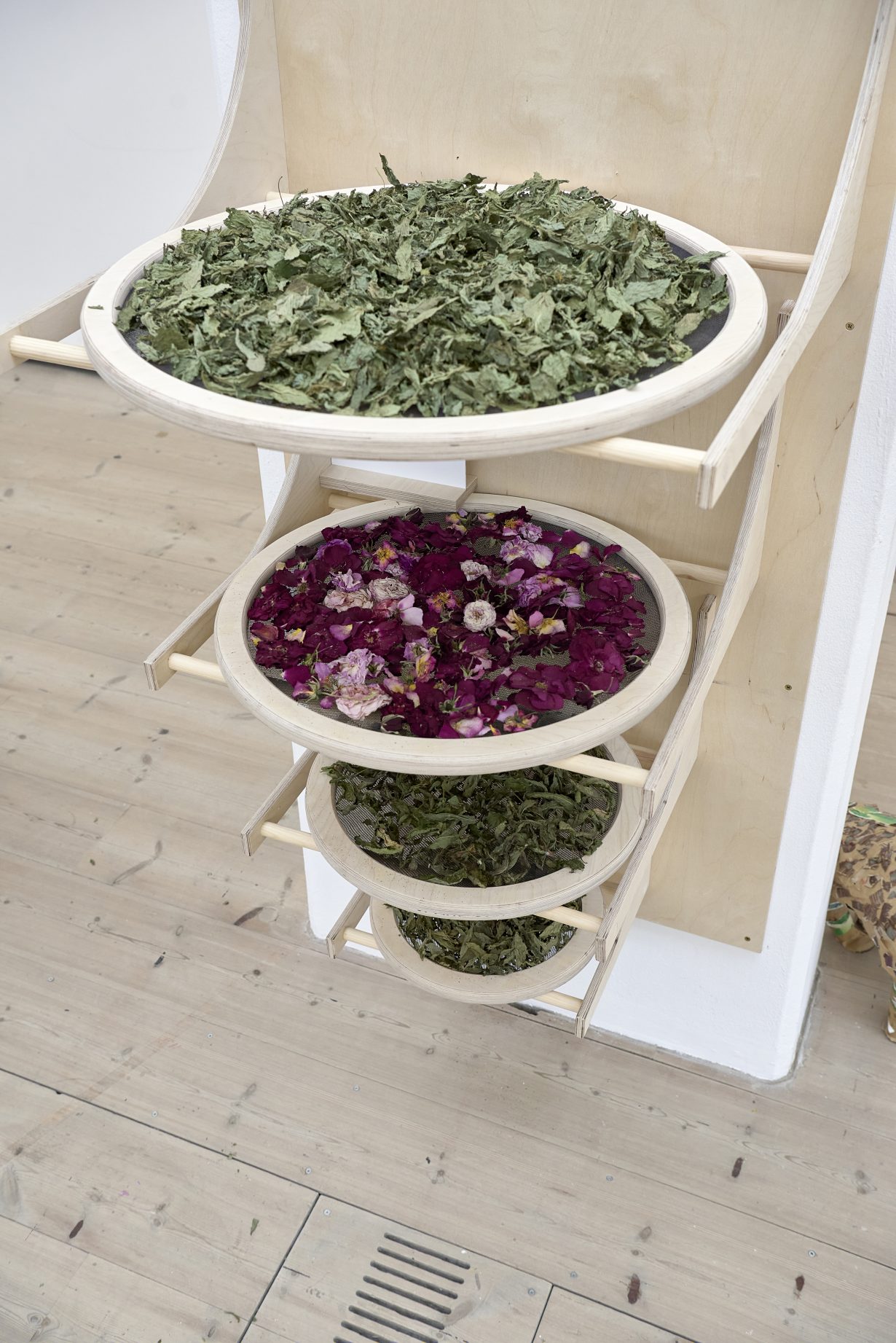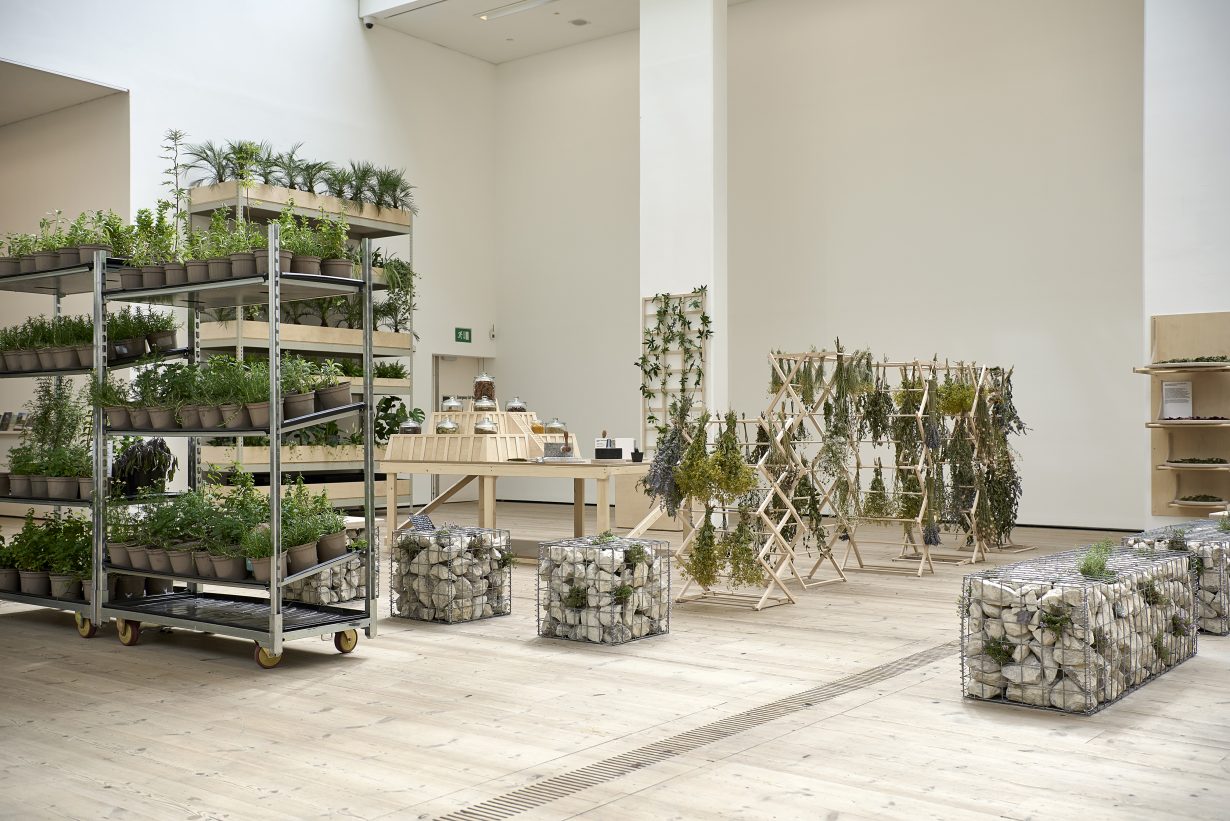Michael Rakowitz’s The Waiting Gardens of the North presents a dream of public space as a place to think, play, be
On entering Michael Rakowitz’s The Waiting Gardens of the North, one is first overwhelmed by the sensations in play in the art: light and smell. Often, one exists in a gallery space far too cerebrally, engaged only with the ‘ideas’ the work is supposed to imply. But here, the work makes its point by placing one first fully, bodily within the space.
Essentially, The Waiting Gardens of the North, which is on at Baltic Centre for Contemporary Art in Gateshead, consists of a huge, white open gallery space, filled with rows upon rows of plant beds, pots and trellises framing tables and benches laid out for communal activities, and crowned by a Babylonian-style banner made of trash harvested from a halal food store. Among the planters herbs, fruit and spice predominate: one smells nutmeg, coffee, tomatoes. The Waiting Gardens of the North is like a dream of public space: the ideal space, within a British conurbation, in which one might come to think, play, be – one in which the rawest experiences of being in space, the lights, the smells, are elevated to the level of the aesthetic.
And yet, this is also an exhibition which mourns the very space it attempts to create. The wall text speaks of ‘waiting’ in the context of forced migration and seeking asylum, thus as representing ‘an in-between time suspended between the past and an uncertain future’. They stand in a ‘North’ that is, in the context of the UK, an embattled space: marginalised from and impoverished by the centre; an area where so many residents now live in uncertainty, thanks to the cost of living crisis, day-to-day. But the word ‘North’ here also contrasts Global North with Global South. The plants here grow almost as memories of a homeland lost: taken, for instance, from the Middle East (which many of Gateshead’s prominent Kurdish community will have left as refugees) or Ukraine (the word ‘Chernobyl’, we are told, comes from ‘Mugwort’). And then, in time, the memories themselves will be lost. The Gardens will be in Gateshead for just under a year, and then they will be packed up. Perhaps the staff will take some of the plants to keep at home, but then the rest of it will be left to die. The space will be gone – it cannot stand here.

In this sense, Rakowitz’s exhibition is both very much of a piece with, and can also be thought to function as a critique of, some of the best shows Baltic has put on recently: Ad Minoliti’s Biosphere Plush (2021); Albert Potrony’s equal play (2021); Sahej Rahal’s Mythmachine (2022); Larry Achiampong’s Wayfarer (2023), whose vintage game consoles are currently available to play on the Level 2 galleries downstairs – shows where the point is less to create something for people to see, than to establish an alternative sort of public space, in which they are invited to do, to touch, to smell, to play.
This is a great niche to carve when you’re a public gallery that gets a lot of kids through the door, that wants its galleries to be spaces where one can laugh and shout, as much as keep quiet, look smart, and scrutinise carefully. In these shows, you get to make your own play equipment, or stamp around a room full of beanbags tripping out to a soundtrack generated by the self-perpetuating mistakes of a video game robot powered by a primitive AI.
At their best, such shows can really become a part of your life: as a Gateshead resident, I used to spend almost every weekend at Baltic with my kids when equal play was on, alternating between the play-gallery and the more permanent second-floor playroom. Equally I could see myself making a habit of dwelling in The Waiting Gardens of the North – not necessarily to play (although there are craft activities laid on for children), but perhaps just to sit, to read, to be. This, as I say, is a dream of public space: exactly the sort of place one wishes would be there to occupy, whenever one wanted to, in a city. Contrast this with the actual public spaces we tend to get: increasingly dirty, poorly maintained, or just exclusive; public-private space where in theory you could be booted out at any time, actual public space where the architecture has been designed to be hostile to certain members of the public (most obviously, people experiencing homelessness).
But then, these dream spaces only exist because they are art shows. And as such, they are necessarily temporary: they exist for a few months, and then they are taken away again. Shows like The Waiting Garden can become an invaluable supplement to the civic fabric. But they are not, almost by definition, a sustainable part of it. These shows exist to experiment, to explore, to demonstrate new possibilities for what public space can be. If they were there forever, they would not fulfil their artistic function in the same way.

And yet: Wouldn’t it be good, if at least some of these experiments were able to make at least some sort of permanent impact on our physical, public reality? The art shows us something new: some different way our public space might be. And then the gallery shuts, the show moves on, and everything is left… exactly the same as it was before, on the same trajectory where things only get worse. Here the art suffers from a problem endemic, I think, to society in general: we can see the better, we know we might be able to arrange, and to live in, a better world. And yet we have absolutely no clue as to how we might get there: no idea whatsoever how to halt the general enshittening of reality that this country, to cite just one example, has been engulfed in (conservatively) since the late-noughties financial crash (and of course this is a global problem, and of course it comes into play differently in countries that are not the UK).
This is the question that most struck me, when visiting Rakowitz’s Waiting Gardens for the first time. How can these spaces actually play a transformative role in terms of how we experience (public) space? What clue do we have as to how we might do anything whatsoever – to transition from the fleeting vision of a better world to the more general realisation of that vision’s promise?
If Waiting Gardens is able to suggest an answer, I think it lies in the sensory experiences the exhibition presents us with, the immediacy of its sights and smells. This temporary space enlivens us to what reality has to offer, in a way that the public space we typically get in cities almost always fails to: the numbness, the drabness, of what the existing order of things has to offer. Children will come here, they will play here, this will be part of their childhood. We can learn what it might be to exist in a world slightly more beautiful than the one we are presently offered. We can loosen our grip on the rubbish – and so the rubbish, in turn, might loosen its grip on us.
